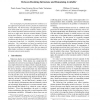Free Online Productivity Tools
i2Speak
i2Symbol
i2OCR
iTex2Img
iWeb2Print
iWeb2Shot
i2Type
iPdf2Split
iPdf2Merge
i2Bopomofo
i2Arabic
i2Style
i2Image
i2PDF
iLatex2Rtf
Sci2ools
SRDS
2006
IEEE
2006
IEEE
Proactive Resilience Revisited: The Delicate Balance Between Resisting Intrusions and Remaining Available
In a recent paper, we presented proactive resilience as a new approach to proactive recovery, based on architectural hybridization. We showed that, with appropriate assumptions about fault rate, proactive resilience makes it possible to build distributed intrusion-tolerant systems guaranteed not to suffer more than the assumed number of faults during their lifetime. In this paper, we explore the impact of these assumptions in asynchronous systems, and derive conditions that should be met by practical systems in order to guarantee long-lived, i.e., available, intrusion-tolerant operation. Our conclusions are based on analytical and simulation results as implemented in M¨obius, and we use the same modeling environment to show that our approach offers higher resilience in comparison with other proactive intrusion-tolerant system models.
| Added | 12 Jun 2010 |
| Updated | 12 Jun 2010 |
| Type | Conference |
| Year | 2006 |
| Where | SRDS |
| Authors | Paulo Sousa, Nuno Ferreira Neves, Paulo Veríssimo, William H. Sanders |
Comments (0)

